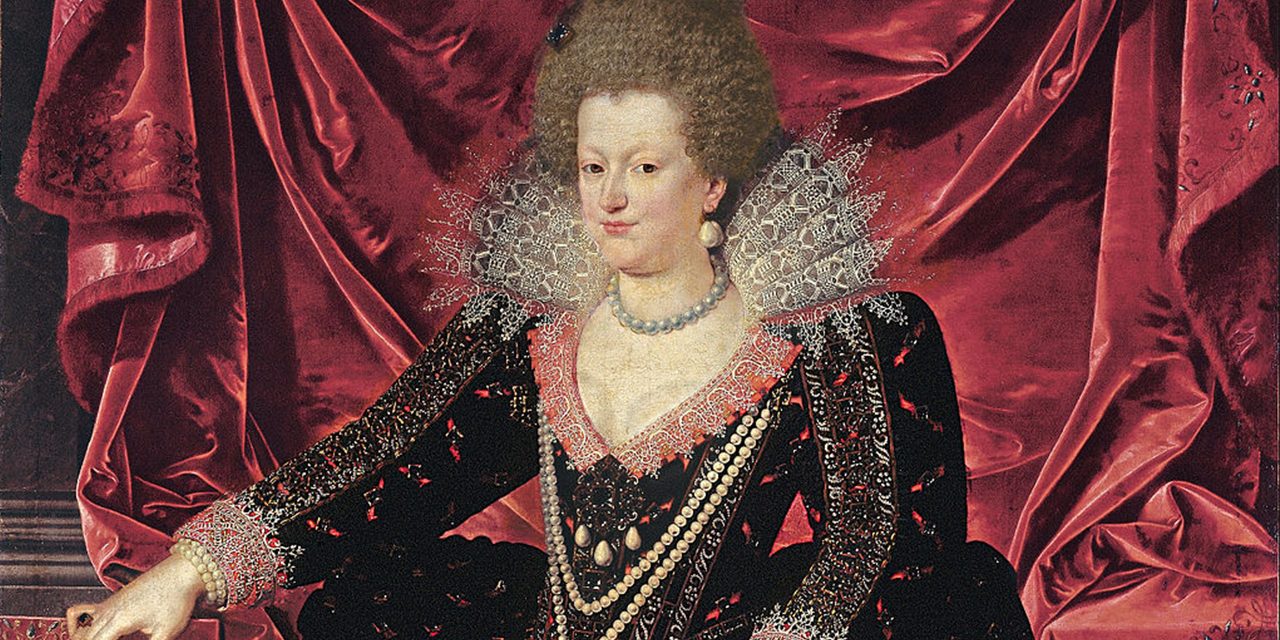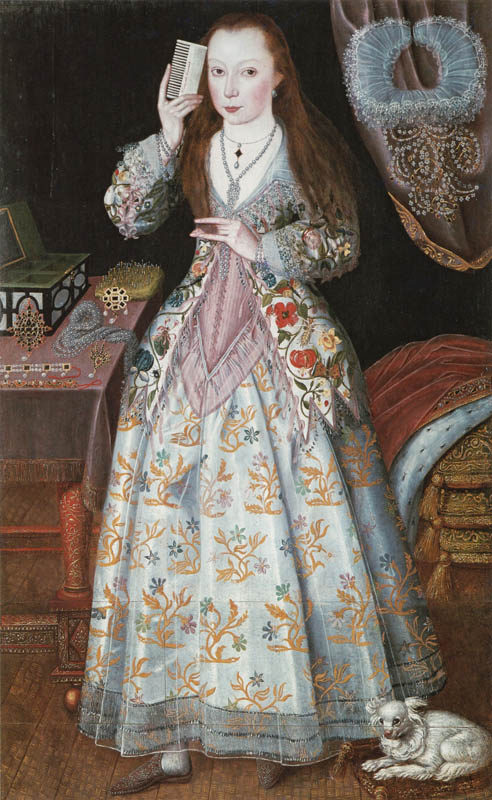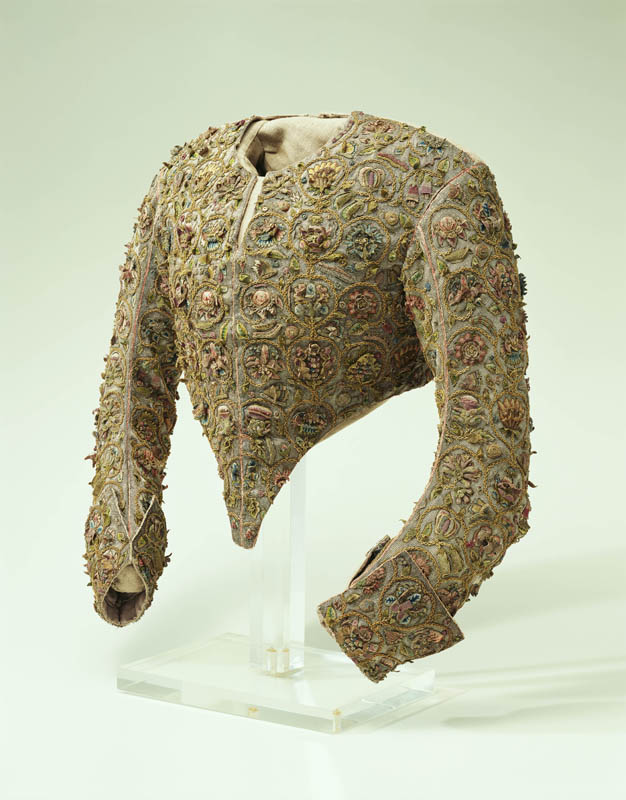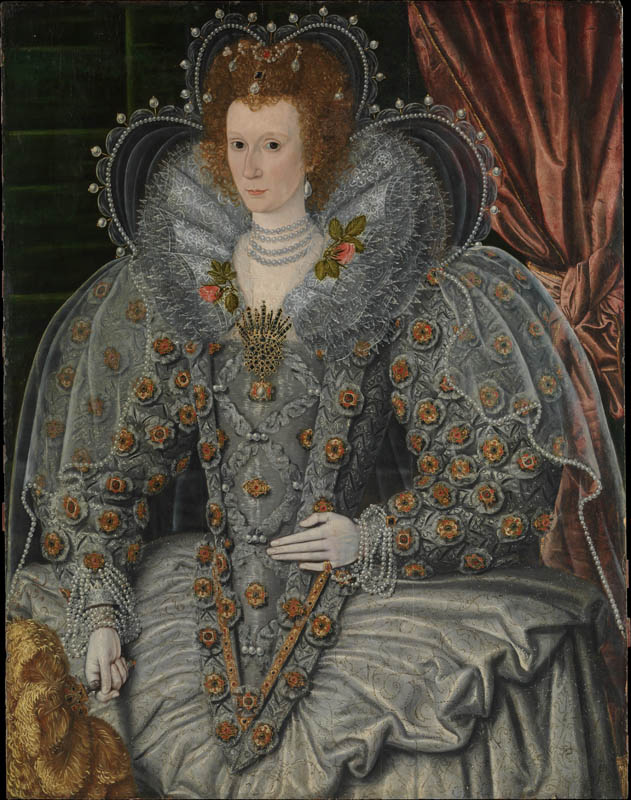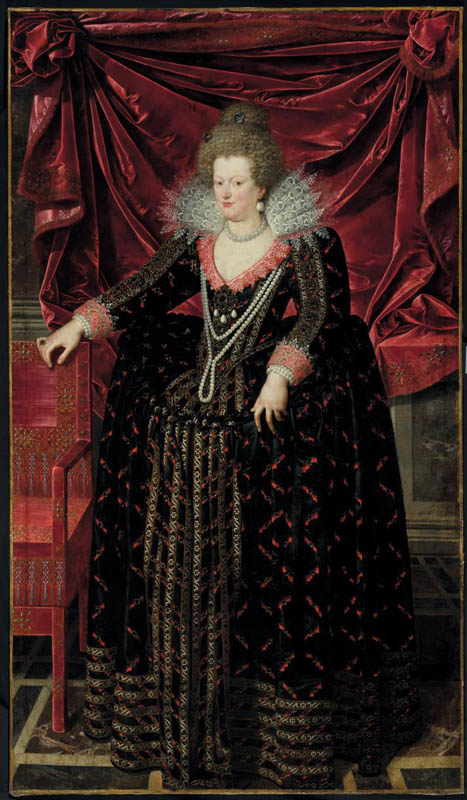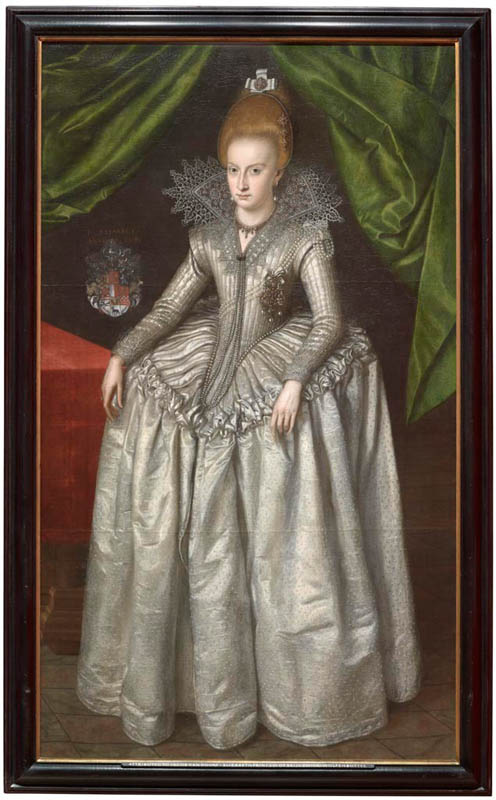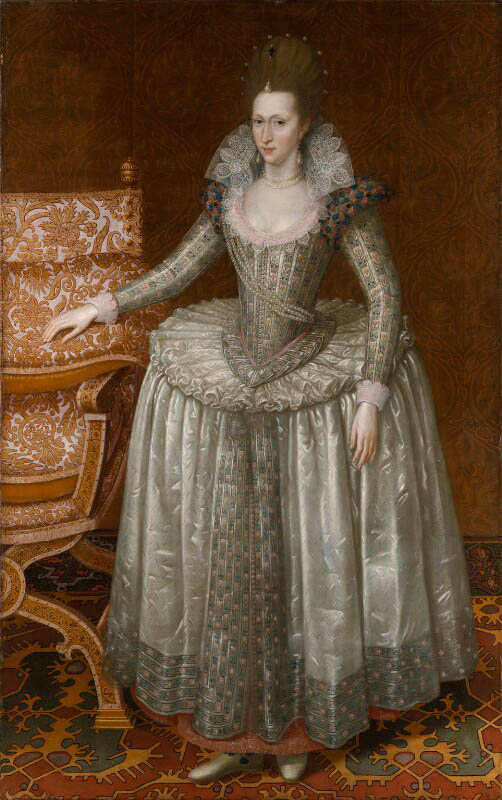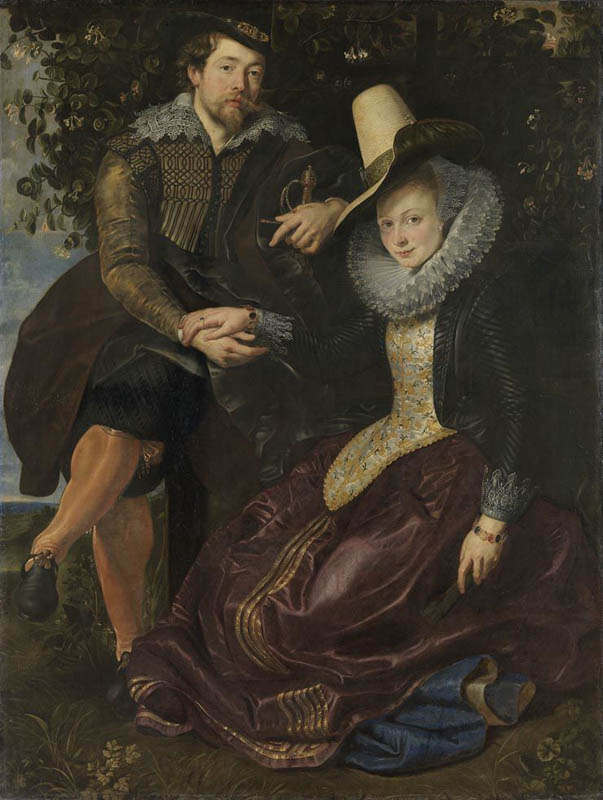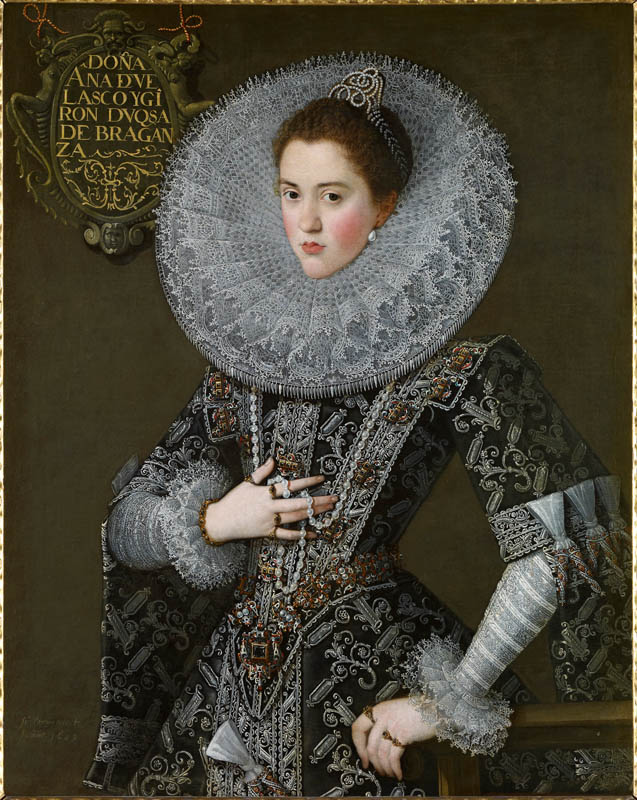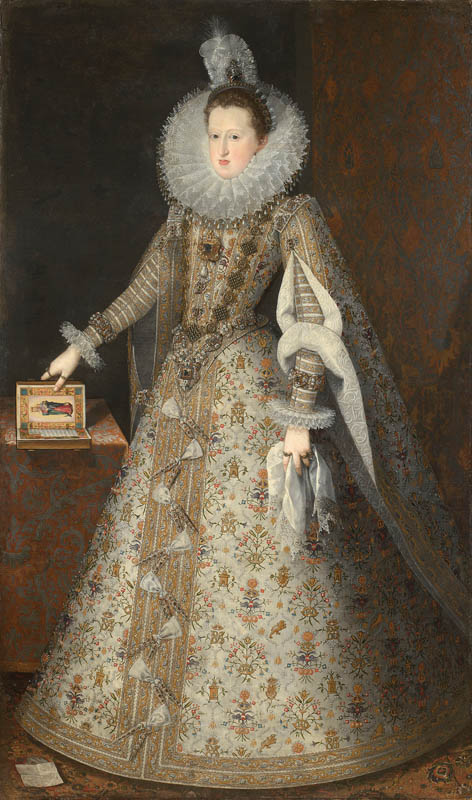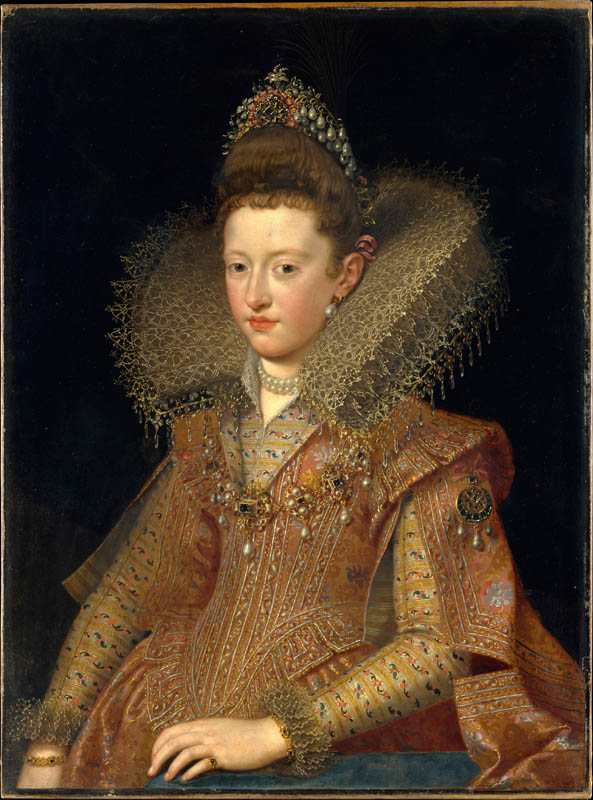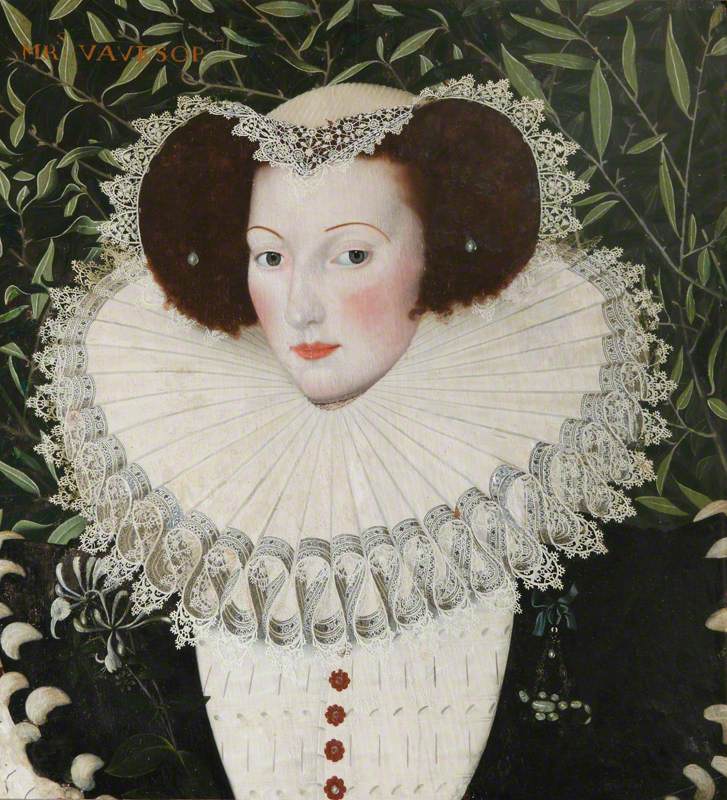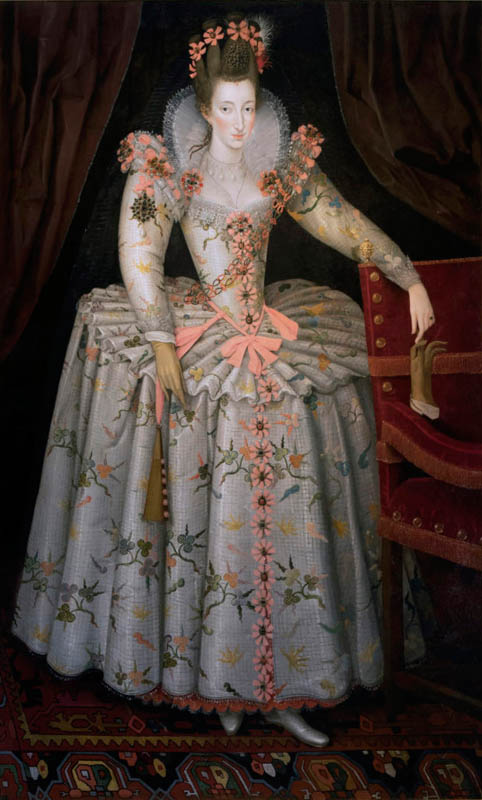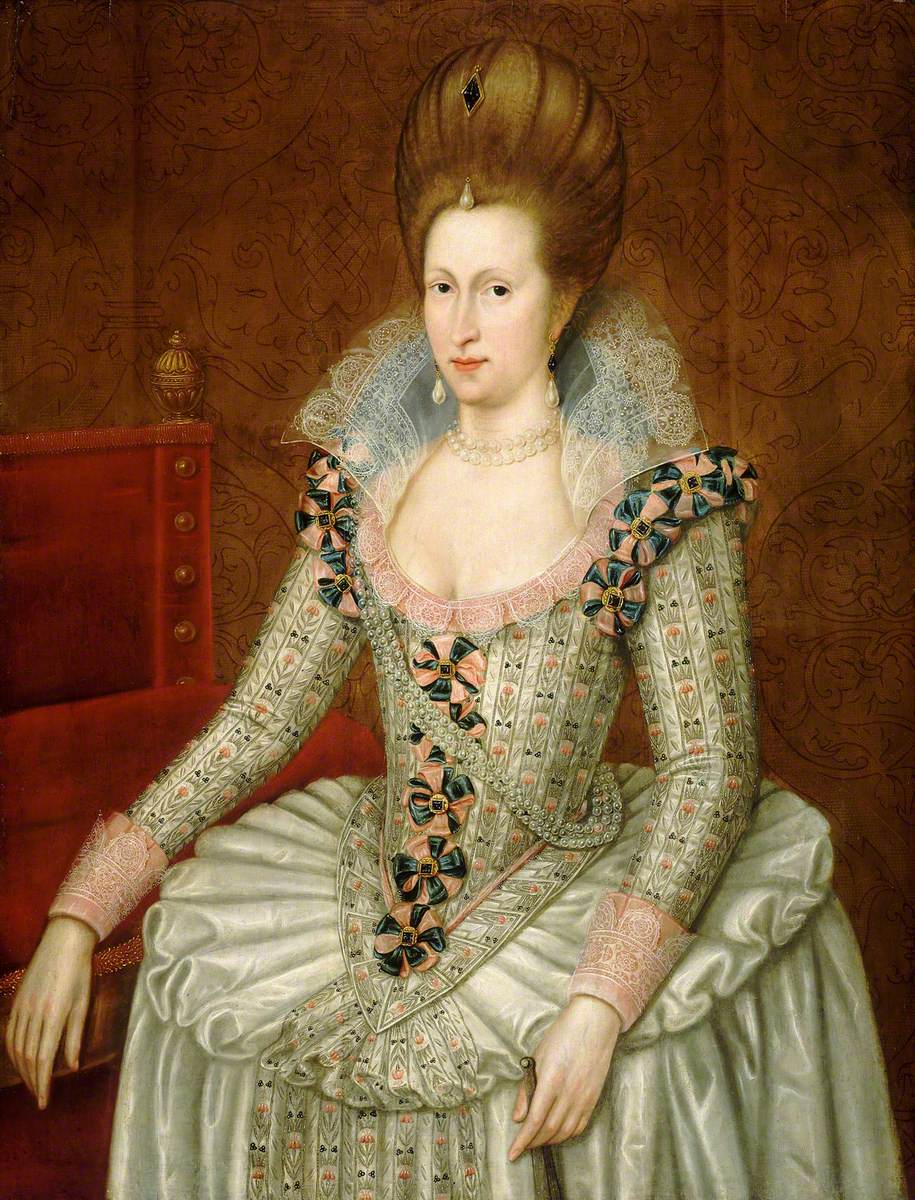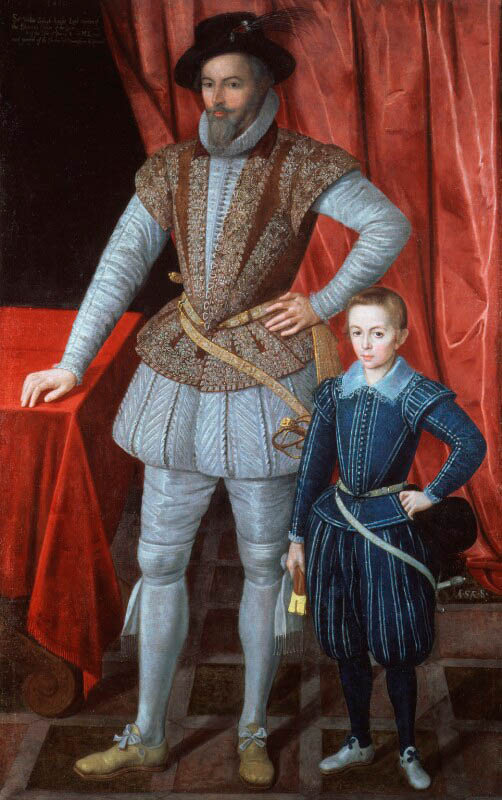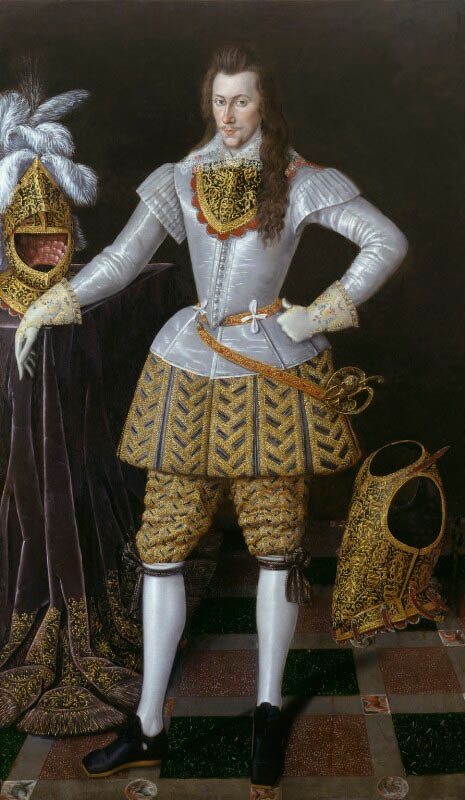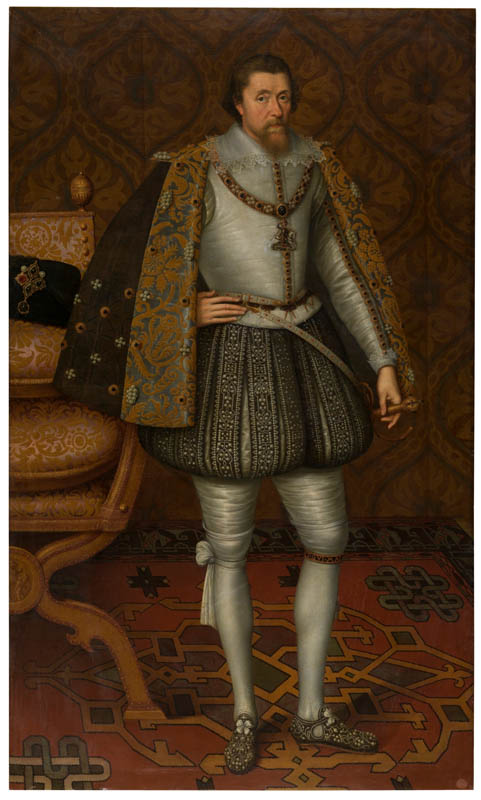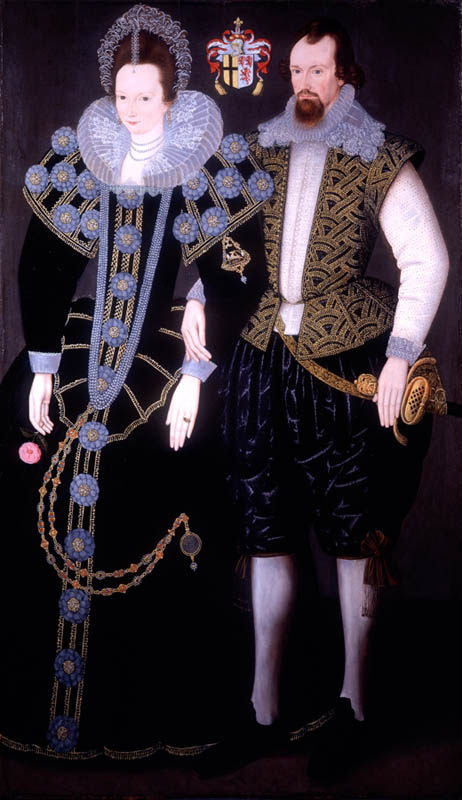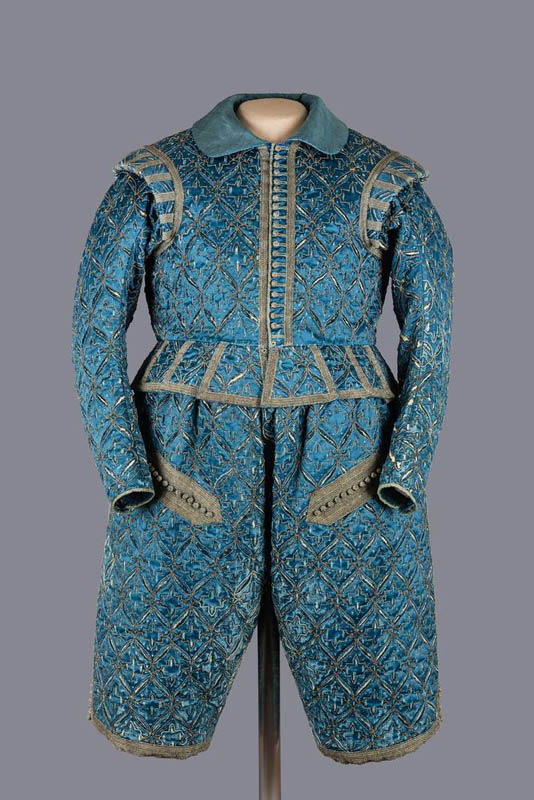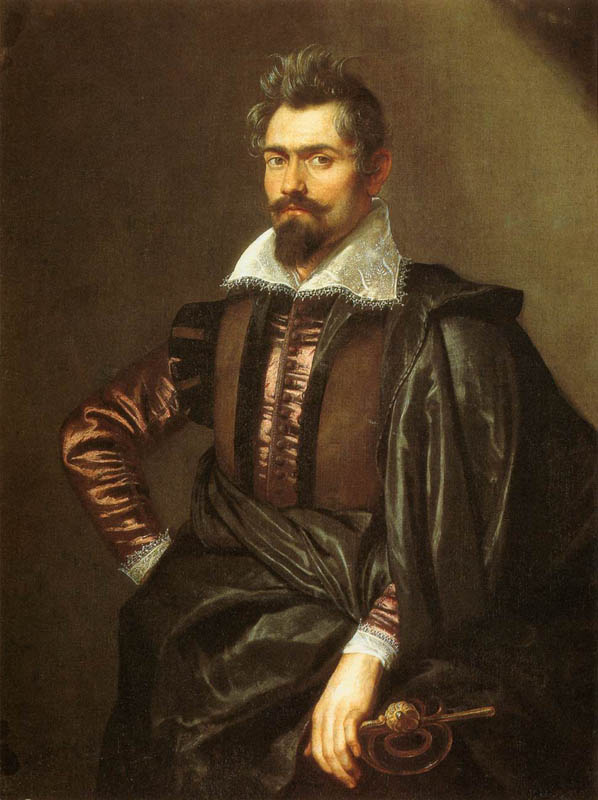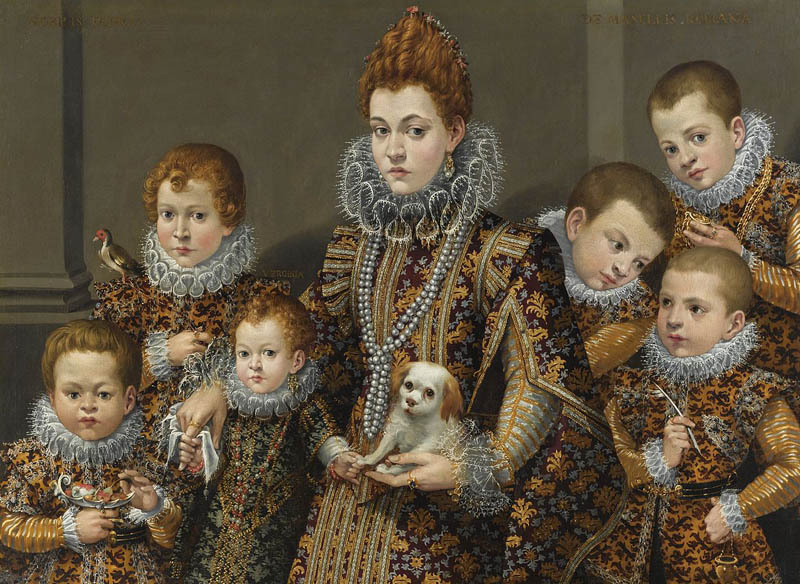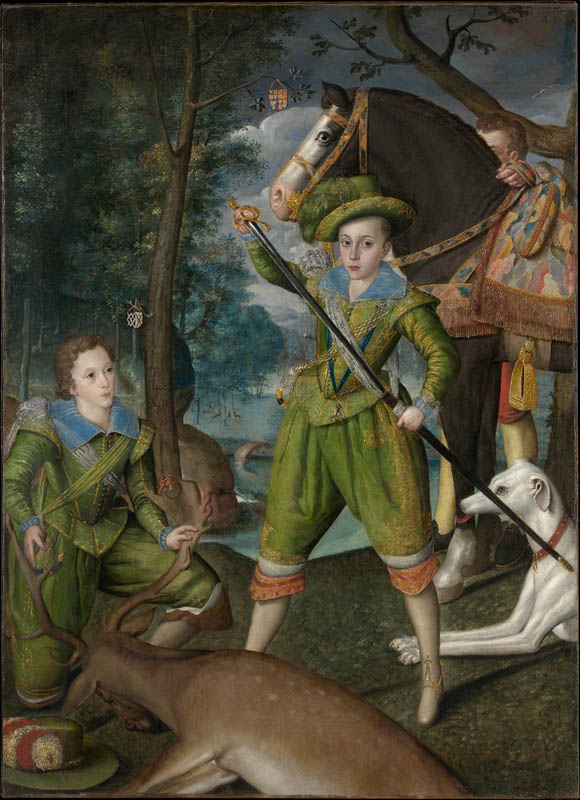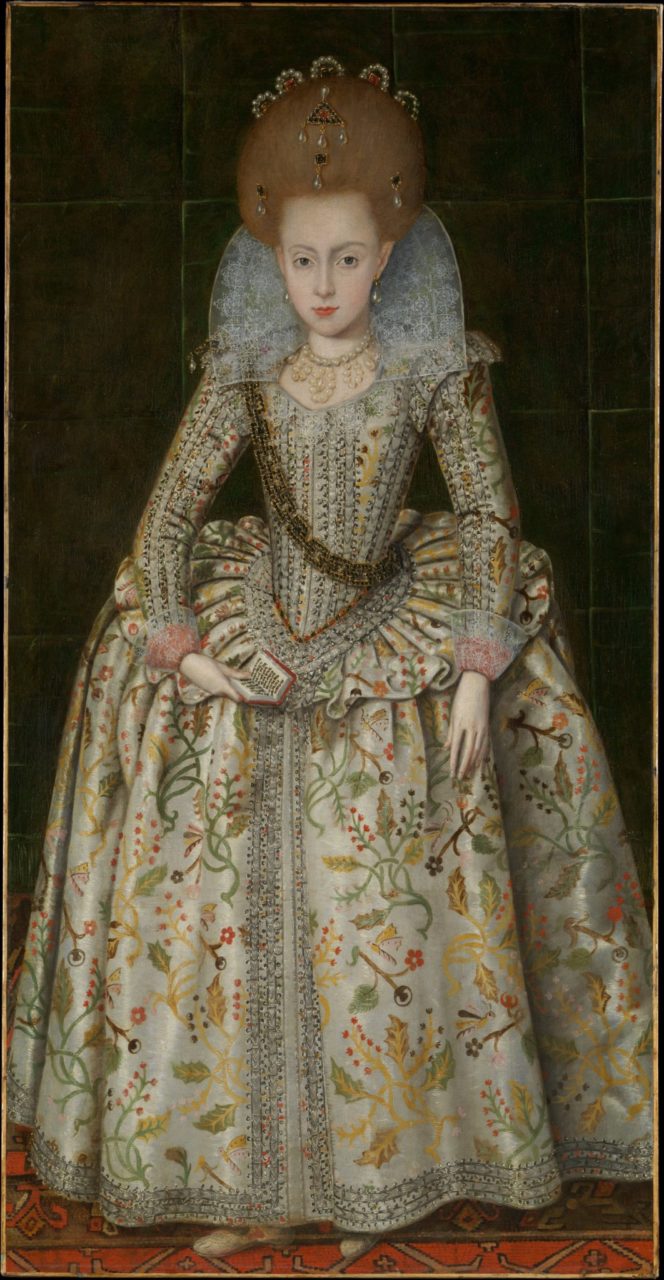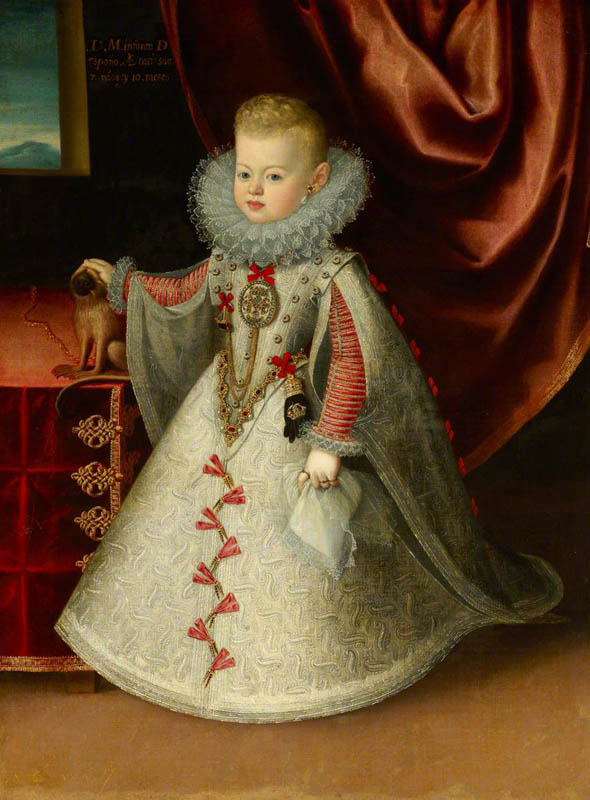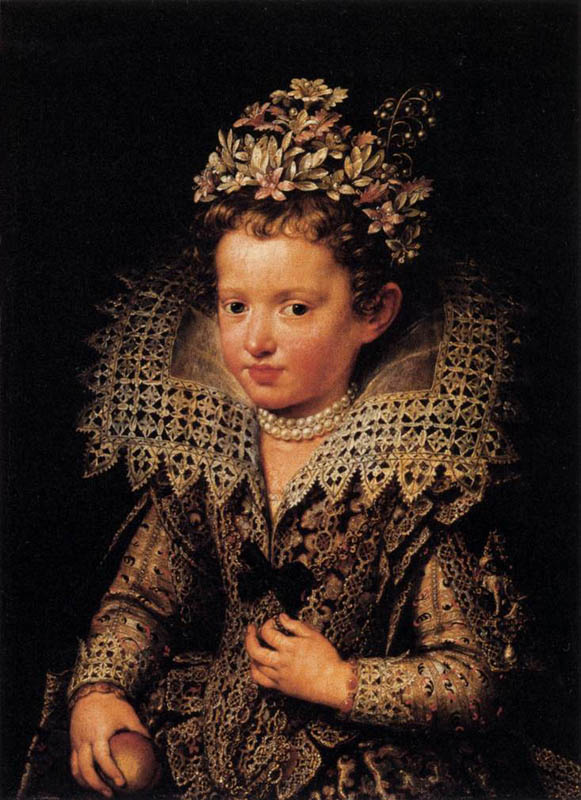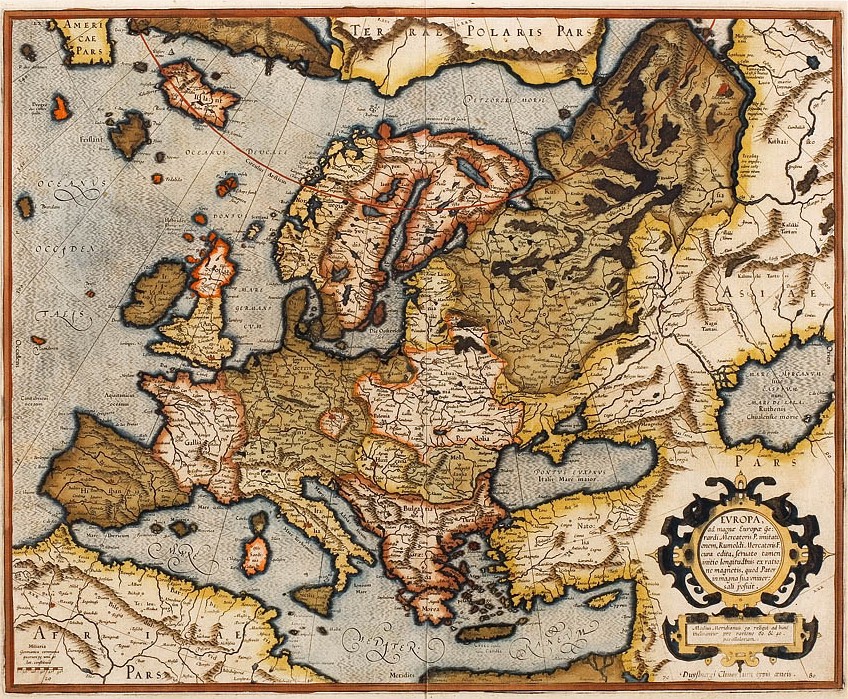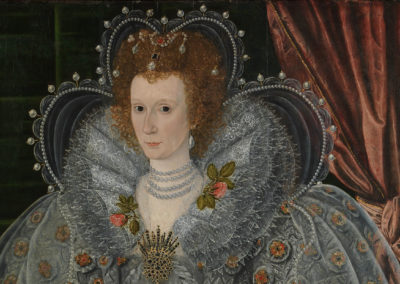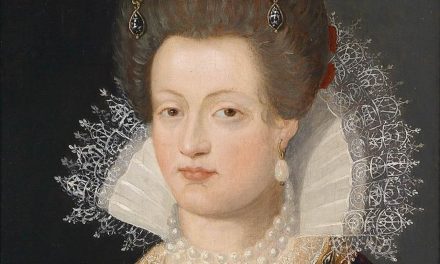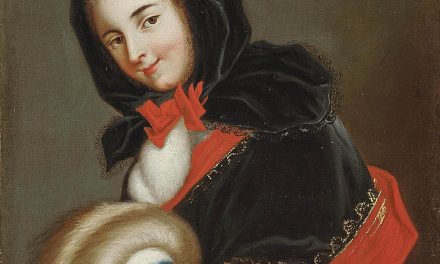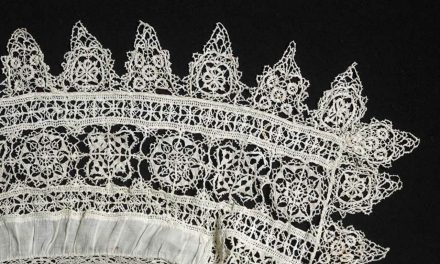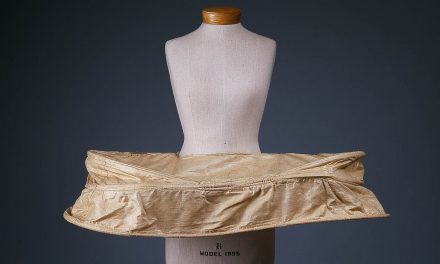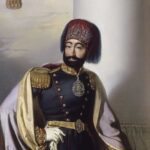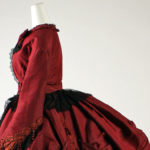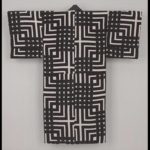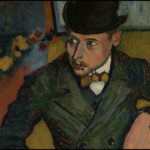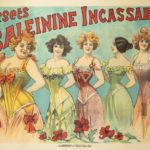OVERVIEW
The first decade of the 17th century saw a continuation of many Elizabethan trends, with small changes in skirt length, sleeve shape, and collar types slowly being introduced.
Womenswear
Just as the reign of Queen Elizabeth I would last into the first years of the seventeenth century, fashion trends of the 1590s would also endure into the new century. Daniel Delis Hill confirms this in The History of World Costume and Fashion (2011), writing that “at the beginning of the seventeenth century, women’s clothing retained many of the contours and design elements from the end of the previous century” (406).
François Boucher offers further details in his History of Costume in the West (1997):
“Elizabethan influence lasted until well after the death of the Queen in 1603. While some forms were inspired by the Continent… drum-farthingales and starched fan collars for women – the volume of the silhouette, the richness and stiffness of materials and the heavily loaded decoration kept the character of sixteenth-century modes. Until about 1620, women still wore embroidered jackets.” (273)
The foundation garment for all dress was the chemise, atop which women now wore stays to create the desirable silhouette of the time. We’re given a rare peek at early seventeenth-century stays in the portrait of Elizabeth Vernon, Countess of Southampton (Fig. 1), who is shown dressing in a rather daringly informal portrait. As Anna Reynolds remarks in In Fine Style (2013): “The countess reveals her long-waisted pink stays beneath her unpinned waistcoat.” (41) Indeed dresses of this period relied heavily on pinning to stay together; on Elizabeth’s dressing table, a cushion full of pins to aid in dressing is visible.
Heavily embroidered bodices, or waistcoats in Vernon’s case, were typical of the period, with the English particularly specializing in floral embroidered pieces. A very fine surviving example from around 1600 in the Kyoto Costume Institute’s collection (Fig. 2) features “roses, peas & beans, forget-me-nots, tulips, irises, carnations, and bellflowers, … birds, caterpillars, snails, spiders, and snakes.” Known as the Devereux Bodice, it is said to have been given to Queen Elizabeth as a gift as part of an unsuccessful plea for clemency by the mother of Robert Devereux, 2nd Earl of Essex (Kyoto).
Fig. 1 - Artist unknown. Elizabeth Vernon, Countess of Southampton, ca. 1600. Oil on panel. Private Collection (Duke of Buccleuch and Queensberry). Source: Wikipedia
Fig. 2 - Maker unknown (English). Bodice, ca. 1600. Plain-weave linen embroidered with metal and silk threads. Kyoto Costume Institute, AC6328 89-16. Gift of Wacoal Corp.. Source: KCI
Fig. 3 - Artist unknown (British). Portrait of a Woman, ca. 1600. Oil on wood; 113 x 88.3 cm (44 1/2 x 34 3/4 in). New York: The Metropolitan Museum of Art, 11.149.1. Gift of J. Pierpont Morgan, 1911. Source: The Met
Fig. 4 - Frans Pourbus the Younger (Flemish, 1569-1622). María de' Medici, Queen of France, 1607. Oil on canvas; 214.7 x 124.5 cm (84.3 x 48.8 in). Bilbao: Fine Arts Museum, 84/86. Bequeathed by Lorenzo Hurtado de Saracho in 1984. Source: Guggenheim Museum Bilbao
Fig. 5 - Jacob Van Doort (Flemish, active 1606-1629). Princess Elizabeth of Brunswick-Wolfenbuttel (1593-1650), later Duchess of Saxe-Altenberg, 1609. Oil on canvas; 194 x 112.5 cm. Royal Collection Trust, RCIN 404963. Source: RCT
Fig. 6 - John de Critz the Elder (Flemish, 1551-1642). Anne of Denmark, ca. 1605-1610. Oil on canvas; 201.6 x 126.5 cm (79 3/8 x 49 3/4 in). National Portrait Gallery: London, NPG 6918. Purchased, 2011. Source: NPG
Fig. 7 - Peter Paul Rubens (Flemish, 1577-1640). Rubens and Isabella Brant in the Honeysuckle Arbor, ca. 1609-10. Oil on canvas; 178 x 136.5 cm. Munich: Alte Pinakothek, 334. Source: Alte Pinakothek
A portrait of an unknown woman from the same period gives a sense of the desired silhouette at the turn of the century (Fig. 3). The wheel-shaped French farthingale was still very much in fashion, though the hard edge of the skirt was often softened by a large ruffle or gathered flounce as we see here. The bodice typically came to a sharp point in the center and large leg-of-mutton sleeves were still favored. This unknown woman even wears the wired veils studded with pearls so favored by Queen Elizabeth herself.
In England and France the large starched ruffs so essential to late 16th-century dress were replaced by still large, but now open, standing collars that framed the face, as Boucher explains: “At the beginning of the century, tall starched collars spreading out in a fan shape round the head were worn by women; this fashion lasted as long as the vogue for the farthingale” (265).
These collars are sometimes referred to as Medici collars as they were worn by Maria de’ Medici, Queen of France (Fig. 4), as we can see in her 1607 portrait by Frans Pourbus the Younger.
There were other changes as well over the course of the decade, particularly to the farthingale, as Hill explains: “the top edge of the farthingale was tilted at a more acute angle with an elevated back and dropped front” (406). Princess Elizabeth of Brunswick-Wolfenbuttel wears the newly fashionable titled farthingale in her 1609 portrait (Fig. 5). Her high hairstyle was also common in this period, as the Royal Collection Trust explains: “Her hair is piled high over pads and decorated with another ribboned jewel and pearls.” Anne of Denmark, Queen consort of England after Elizabeth’s death and wife to King James VI and I, wears a similar hairstyle (Fig. 6).
In Anne’s portrait we also see two new fashion trends, the first being much narrower sleeves: “padded leg-of-mutton sleeves were replaced with close-fitting cylindrical types that were cropped several inches short of the wrist” (Hill 406). The second trend was “shortened hems to make feet—in new, heeled shoes, visible for the first time. These [shortened] skirts marked France’s ascent as Europe’s’ fashion leader” (Brown 98). Anne was said to have brought other French trends to the English court, including a preference for rather low necklines that revealed the bust (a less extreme version can be seen in figure 4, the portrait of Maria de’ Medici then Queen of France).
Elsewhere in Europe, fashions changed more slowly. In Spain and Holland, the large cartwheel ruff was retained as figure 7 attests:
“Flemish artist Rubens painted his wife, Isabella Brandt, wearing this huge ruff edged with lace. Ruffs achieved their greatest width in the Low Countries, where starching techniques originated. The low, curved bodice front also became a regional style.” (Brown 98)
Fig. 8 - Juan Pantoja de la Cruz (Spanish, 1553-1608). Doña Ana de Velasco y Girón, 1603. Collection of Alicia Koplowitz. Source: Peacock Plume
Fig. 9 - Juan Pantoja de la Cruz (Spanish, 1553-1608). Margaret of Austria, Queen Consort of Philip III of Spain, ca. 1605. Oil on canvas; 204.6 x 121.2 cm. Hampton Court: Cumberland Art Gallery, RCIN 404970. Source: Royal Collection Trust
Fig. 10 - Frans Pourbus the Younger (Netherlandish, 1569-1622). Margherita Gonzaga, Princess of Mantua, 1606. Oil on canvas; 92.7 x 69.2 cm (36 1/2 x 27 1/4 in). New York: The Metropolitan Museum of Art, 25.110.21. Bequest of Collis P. Huntington, 1900. Source: The Met
Another terrifically elaborate ruff features in Juan Pantoja de la Cruz’s 1603 portrait of Doña Ana de Velasco y Girón (Fig. 8). Pantoja de la Cruz’s portrait of Margaret of Austria, Queen Consort of Philip III of Spain (Fig. 9), offers another example of Spanish court fashion where the cone-shaped Spanish farthingale also endured, as did the enthusiasm for long hanging sleeves (Hill 406). Italian styles featured elements that were popular at other courts, retaining the Spanish hanging sleeves, for example, but adopting an open standing ruff, a hybrid of the cartwheel ruff and the open standing collar (or Medici collar), as seen in Pourbus’s portrait of Margherita Gonzaga, Princess of Mantua (Fig. 10).
Fashion Icon: Anne Vavasour (1560-1654)
Fig. 1 - Robert Peake (English, 1551-1619). Ann Vavasour, ca. 1600. 55.5 x 51. Guildford: National Trust, Hatchlands, 1166065_CC279. on loan from the Cobbe Collection (accession no. 279). Source: Art UK
Fig. 2 - John de Critz (Flemish, 1551-1642). Anne Vavasour, ca. 1605. London: Hall of The Worshipful Company of Armourers and Brasiers. Source: On the Tudor Trail
Fig. 3 - John de Critz the elder (Flemish, 1551-1642). Anne of Denmark, ca. 1605. Oil on panel; 113.5 x 86.5 cm. National Maritime Museum: London, BHC4251. Source: Art UK
The beautiful Anne Vavasour (Fig. 1) achieved early success in life by joining Queen Elizabeth’s household in the late 1570s, as Tudor historian Bart Casey explains:
“many heads were turning in the direction of Anne, who had recently come to court from Yorkshire as a Gentlewoman of the Bedchamber, the queen’s most intimate group of attendants. The girl had been groomed since childhood to follow in the footsteps of her uncle Sir Thomas Knyvet, who was a Groom of the Privy Chamber, and her aunt Katherine Knyvet, a Maid of Honour. The Knyvet family was well known and well loved at court since the early days of King Henry VIII when an older Thomas Knyvet had been the king’s Master of the Horse.”
This attention soon became serious as she became the lover of Edward de Vere, 17th Earl of Oxford, a turn of events which became disastrous when she soon gave birth to a son, Edward. The Queen’s spymaster, Sir Francis Walsingham, wrote a letter on 23 March 1581, describing the affair:
“On Tuesday at night Anne Vavasour was brought to bed of a son in the maidens’ chamber. The E. of Oxford is avowed to be the father, who hath withdrawn himself with intent, as it is thought, to pass the seas. The ports are laid for him and therefore if he have any such determination it is not likely that he will escape. The gentlewoman the selfsame night she was delivered was conveyed out of the house and the next day committed to the Tower. Others that have been found any ways party to the cause have also been committed. Her Majesty is greatly grieved with the accident, and therefore I hope there will be some such order taken as the like inconvenience will be avoided.” (Casey)
As the letter suggests, both Anne and the Earl were sent to the Tower of London by orders of the Queen.
Yet that was not the end of Anne’s story; after her release, she later became the mistress of Sir Henry Lee of Ditchley. Sir Henry had been Queen Elizabeth’s personal champion at the joust, but in 1590 at the age of fifty-seven, he was a widower. Casey continues the story:
“His wife and three children were all dead, and he was facing lonely years ahead. And that’s when he invited Anne Vavasour, then about age twenty-seven, to join him (with her child) as his mistress and de facto wife. She not only accepted but also soon gave birth to her second child, fathered by Sir Henry.”
Considering the Queen had banished Anne to the Tower less than ten years before, Anne (and Sir Henry’s) situation was somewhat precarious. Sir Henry thus organized a charm offensive, commissioning poetry and most importantly what’s known now as the Ditchley portrait of Queen Elizabeth. A highly flattering rendering of the Queen astride the globe, the portrait tellingly includes the inscription: “she can, but she does not, take revenge.”
The campaign was successful with the Queen and her court even visiting Ditchley in 1592. Sir Henry and Anne were able to live happily at Ditchley throughout the rest of Elizabeth’s reign and even became close with the court of King James VI and I. Anne Vavasour and Queen Anne of Denmark seem to have gotten on well and even commissioned quite similar portraits (Figs. 2-3) from John de Critz around 1605, where both wear white satin gowns with French farthingales and open standing collars and stand next to the same red chair. Anne’s bodice is low, like that of the Queen, and both are decorated with pink ribbon rosettes. They share an “upswept, formal hairstyle, its structured braids elaborately decorated, [that] marks a temporary elongation of the female appearance” (Cumming 23).
An earlier portrait (Fig. 1) had shown Anne in black and white, the favored colors of Queen Elizabeth and with the pale powdered face also made fashionable by the Queen, suggesting Vavasour was quite adept at manipulating her appearance to suit the times.
Menswear
As in womenswear, early 17th-century menswear styles maintained the basic features of late 16th-century dress, as Hill details, “Doublets continued to be tight-fitting, though without the peascod belly… Whisks and ruffs were still rigidly starched and supported by wire frames” (397).
Sir Walter Ralegh and his son (Fig. 1) both wear tight-fitting doublets—Ralegh also wears a jerkin unbuttoned to the navel. Sir Walter wears bulbous trunk hose with canions, while his son sports knee-length Venetians. Elaborate surface embellishment, made popular under Queen Elizabeth, continued; as the National Portrait Gallery notes, “Ralegh’s jacket is embroidered with seed pearls, and his son’s blue suit is silver-braided.” Both wear swords at their hips; swords were the must-have accessory of the 17th century, typically worn attached at the waist via belt as seen here.
Ralegh still wears a small stiff ruff, whereas his son wears a floppy, lace-edged collar instead. Boucher explains the diversity of collar styles then in vogue: “Ruffs could be round, as in the preceding period, or soft and falling, or alternatively a stiff collar (collet monté) supported by a frame could be worn” (252). There were even two other options beyond those, in fact: standing bands (lace-edged collars stiffened with starch that stood up and flared away from the neck at the sides and back) or falling bands (lace-edged collars made of silk or linen that fastened at the neck and draped over the shoulders, chest, and back). Ralegh’s son wears a falling band as do all the other men pictured (Figs. 2-7).
Fig. 1 - Artist unknown. Sir Walter Ralegh (Raleigh); Walter Ralegh, 1602. Oil on canvas; 199.4 x 127.3 cm (78 1/2 x 50 1/8 in). London: National Portrait Gallery, NPG 3914. Given by the Lennard family, 1954. Source: NPG
Fig. 2 - Artist unknown. Henry Wriothesley, 3rd Earl of Southampton, ca. 1600. Oil on canvas; 204.5 x 121.9 cm (80 1/2 x 48 in). London: National Portrait Gallery, NPG L114. Lent by a private collection, 1964. Source: NPG
Fig. 3 - John de Critz (Flemish, 1551-1642). James I of England, ca. 1605. Oil on canvas; 196 x 120 cm. Madrid: Museo del Prado, P001954. Source: Prado
Fig. 4 - Artist unknown. Sir Reginald Mohun, 1st Baronet (c1564–1639) of Boconnoc, MP, and his 3rd wife Dorothy Chudleigh, ca. 1603/4. Oil on panel; 190.5 x 111.4 cm (75 x 44 1/4 in). Private Collection. Source: Wikipedia
Henry Wriothesley, 3rd Earl of Southampton, gives a good idea of what more fashion-forward menswear looked like ca. 1600 (Fig. 2). He wears a white satin doublet, all buttoned up, with gold-braided trunk hose and coordinating canions, bright white hose held up with ribbon garters, and a limp lace-edged falling band at his shoulders. The National Portrait Gallery remarks: “Southampton was known at court for his flamboyant appearance, particularly his auburn hair, which he wore long as shown in this portrait.” He also wears white leather gloves with embroidered gauntlets—a very fashionable accessory in the 17th century. The overall effect was to emphasize a narrow waist, as Valerie Cumming explains in A Visual History of Costume: The Seventeenth Century (1984):
“The fashions of the late Elizabethan period produced wide shoulders and hips which enhanced a narrow waistline.” (Cumming 18)
King James I of England wears a similar set of clothes in a ca. 1605 portrait (Fig. 3), though his doublet features a line of ribbons with gold-tipped points along the waistline, which would become a fashionable detail for several decades. His trunk hose are encrusted with seed pearls as Ralegh’s jerkin had been. King James wears a cape draped over his shoulders, which are topped by a falling band. As for footwear, Boucher describes the latest styles:
“With Henri IV… shoes developed more solid forms, which were to stay in fashion without major change for most of the century: they were fastened on the instep with a bow, then with a buckle” (266).
Versions of these shoes can be seen in figures 1-4. Sir Reginald Mohun (Fig. 4) wears a white satin doublet, black and gold jerkin, dark trunk hose and canions. His jerkin like Ralegh’s is unbuttoned; but jerkins in general were on their way out, being rarely seen after 1620 (Cunnington 12).
Fig. 5 - Maker unknown (German). Pomp dress of the Elector Christian II of Saxony, ca. 1601-1611. Outer fabric silk atlas blue, slit pattern with open edges, lined with silk fabric, bright natural color in plain weave; silver canteilles and silver filaments with silk blue; lining fabrics: silk material medium blue, barchent natural light, linen reinforcement dark brown; trouser leg partly quilted with cotton fleece and quilted; chest circumference 130 cm. Dresden: Staatliche Kunstsammlungen, i. 0007.01. Source: SKD
Fig. 6 - Peter Paul Rubens (Flemish, 1577-1640). Kaspar Schoppe, ca. 1606. Oil on canvas; 116 x 88 cm (45.7 x 34.6 in). Florence: Pitti Palace. Source: WIkipedia
Fig. 7 - Peter Paul Rubens (Flemish, 1577-1640). Rubens and Isabella Brant in the Honeysuckle Arbor, ca. 1609-10. Oil on canvas; 178 x 136.5 cm. Munich: Alte Pinakothek, 334. Source: Alte Pinakothek
There was a new enthusiasm for coordinating ensembles, as in the pomp dress of the Elector Christian II of Saxony (Fig. 5). As the Cunningtons remark in their Handbook of English Costume in the Seventeenth Century (1972): “During the first half of the century a gentleman’s suit consisted of doublet, hose or breeches, mandilion or cloak, all made to match or harmonise, with trimmings en suite” (11-12). Long, knee-length breeches like those seen here would soon replace the combination of trunk hose and canions seen in the English portraits. In the Low Countries, we see a more subdued palette in menswear looks generally. Kaspar Schoppe (Fig. 6) sports a sash, which will become a common accessory, particularly in the Netherlands. Rubens in his self-portrait (Fig. 7) wears a striking pair of orange hose—brightly colored hose also become a fashion trend in this period. Both men wear falling bands with their tight-fitting satin doublets.
CHILDREN’S WEAR
Fig. 1 - Lavinia Fontana (Italian, 1552-1614). Bianca degli Utili Maselli with 6 of her children, ca. 1604-05. Oil on canvas; 99 x 133.3 cm (39 x 52.5 in). Private Collection. Source: Wikipedia
Fig. 2 - Robert Peake the Elder (British, 1551-1619). Henry Frederick (1594–1612), Prince of Wales, with Sir John Harington (1592–1614), in the Hunting Field, 1603. Oil on canvas; 201.9 x 147.3 cm (79 1/2 x 58 in). New York: The Metropolitan Museum of Art, 44.27. Purchase, Joseph Pulitzer Bequest, 1944. Source: The Met
Princess Elizabeth, aged about 15 (Fig. 3), wears a dress nearly identical to that seen on Anne Vavasour and Queen Anne of Denmark (see “Fashion Icon” section above), complete with French farthingale, standing lace collar, and elaborate high hairstyle. Maria Anna, Infanta of Spain (Fig. 4), is dressed nearly identically to her mother, Margaret of Austria, Queen of Spain (Fig. 9 above). Eleanora of Mantua, then a Princess and later Holy Roman Empress, appears not at all childlike in her portrait by Frans Pourbus when she was about 7 (Fig. 5), which is perhaps for the best as such portraits were typically used in marriage negotiations between noble families.
Fig. 3 - Robert Peake the Elder (British, 1551-1619). Princess Elizabeth, Later Queen of Bohemia, ca. 1606. Oil on canvas; 154.3 x 79.4 cm (60 3/4 x 31 1/4 in). New York: The Metropolitan Museum of Art, 51.194.1. Gift of Kate T. Davison, in memory of her husband, Henry Pomeroy Davison, 1951. Source: The Met
Fig. 4 - Bartolomé González (Spanish, 1564-1627). Maria Anna, Infanta of Spain, Later Archduchess of Austria, Queen of Hungary and Empress, as a Child, ca. 1608/1610. Oil on canvas; 106.5 x 75 cm (41.9 x 29.5 in). Cliveden: National Trust, 766121. presented to the National Trust with the house and grounds by Waldorf, 2nd Viscount Astor, 1942. Source: Art UK
Fig. 5 - Frans Pourbus the Younger (Flemish, 1569-1622). Eleonora of Mantua as a Child, ca. 1605. Oil on canvas; 64 x 49 cm (25.1 x 19.2 in). Florence: Pitti Palace. Source: Wikipedia
References:
- Boucher, François, Yvonne Deslandres, and John Ross. A History of Costume in the West. London: Thames and Hudson, 1997. http://www.worldcat.org/oclc/443676264.
- Brown, Susan, ed. Fashion: The Definitive History of Costume and Style. New York: DK Publishing, 2012. http://www.worldcat.org/oclc/840417029.
- Casey, Bart. “A Tudor Love Story: Anne Vavasour and Sir Henry Lee.” Accessed January 13, 2020. https://onthetudortrail.com/Blog/2019/03/17/a-tudor-love-story-anne-vavasour-and-sir-henry-lee/.
- Kyoto Costume Institute Digital Archive. “Collections |Collections -1700s|KCI Digital.” Accessed January 13, 2020. https://www.kci.or.jp/archives/digital_archives/.
- Cumming, Valerie. A Visual History of Costume: The Seventeenth Century. 3. London: Batsford, 1984. http://www.worldcat.org/oclc/9761398.
- Cunnington, C. Willett, and Phillis Emily Cunnington. Handbook of English Costume in the Seventeenth Century. Boston: Plays, Inc, 1972. http://www.worldcat.org/oclc/755269282.
- Hill, Daniel Delis. History of World Costume and Fashion. Upper Saddle River, NJ: Pearson Prentice Hall, 2011. http://www.worldcat.org/oclc/768100950.
- Royal Collection Trust. “Jacob van Doort (d. 1629) – Princess Elizabeth of Brunswick-Wolfenbuttel (1593-1650), Later Duchess of Saxe-Altenberg.” Accessed January 13, 2020. https://www.rct.uk/collection/404963/princess-elizabeth-of-brunswick-wolfenbuttel-1593-1650-later-duchess-of-saxe.
- National Portrait Gallery. “Henry Wriothesley, 3rd Earl of Southampton.” Accessed January 13, 2020. https://www.npg.org.uk/collections/search/portrait/mw05918/Henry-Wriothesley-3rd-Earl-of-Southampton.
- ———. “Sir Walter Ralegh (Raleigh); Walter Ralegh.” Accessed January 13, 2020. https://www.npg.org.uk/collections/search/portrait/mw05205/Sir-Walter-Ralegh-Raleigh-Walter-Ralegh.
- Reynolds, Anna. In Fine Style: The Art of Tudor and Stuart Fashion. London: Royal Collection Trust, 2013. http://www.worldcat.org/oclc/824726826.
Historical Context
Wikipedia: 1610-1619
Rulers:
- England
- Elizabeth I (1558–1603)
- James VI and I (1603-1625)
- France
- Henry IV (1589–1610)
- Spain
- Philip III (1598–1621)
Map of Europe, 1595. Source: Wikimedia Commons
Events:
- 1600 – The East India Company is granted a Royal Charter in the Kingdom of England for trade with Asia.
- 1601 – Possible first performance of William Shakespeare’s tragedy Hamlet.
- 1603 – James I is crowned as King of England in Westminster Abbey.
- 1605 – Guy Fawkes is arrested for trying to kill King James I of England, AKA. The Gunpowder Plot of November 5th.
- 1605 – Hemlines go up to show feet, following the introduction of heeled shoes for the rich, hence the expression “well heeled.”
- 1606 – Jamestown, Virginia, is established as the first permanent English settlement in North America.
- 1609 – Galileo Galilei demonstrates his first telescope to Venetian officials.
Timeline Entries
Primary/Period Sources
Resources for Fashion History Research
To discover primary/period sources, explore the categories below.
Have a primary source to suggest? Or a newly digitized periodical/book to announce? Contact us!
Primary/Period Sources
Secondary Sources
Also see the 17th-century overview page for more research sources… or browse our Zotero library.

